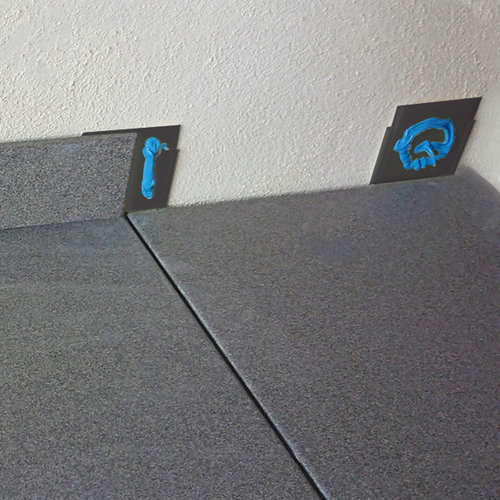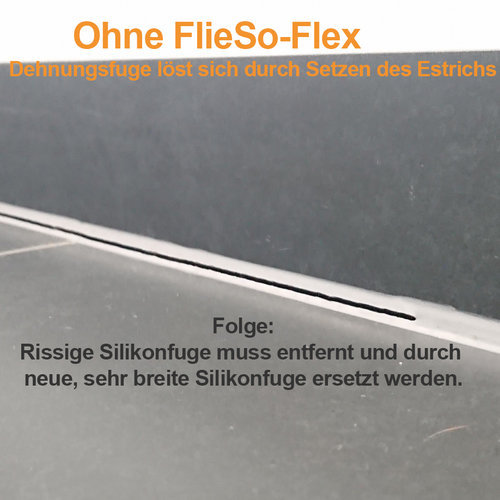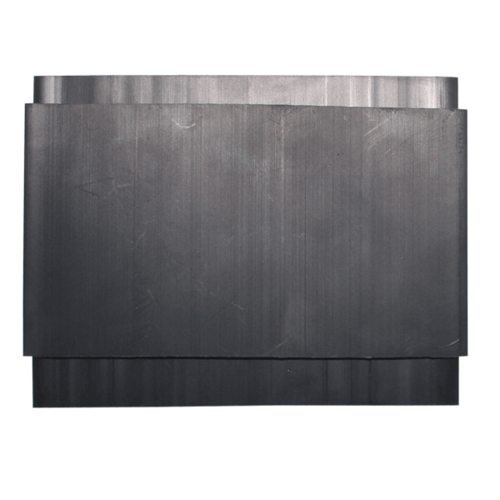Fliesoflex, 200 pcs, order no 12596
Fliesoflex - the flexible tile base
Never again torn silicone joints in the base area thanks to the Fliesoflex innovation!
After the construction site is before the construction site: many homeowners have to realize that many small construction sites also occur years after the completion of their house. It often happens that the screed is lowered by several millimetres in the first few years, sometimes up to 2 cm.
Since the plinth tile is fixed to the wall and cannot move downwards with it, the silicone joint tears and has to be replaced at great expense. Beside the high costs and the additional effort of the repair still comes that the newly created expansion joint usually looks very thick and optically not so appealing any more. Some people therefore only install the base years later in order to avoid this trouble. But clever ones use our new, patented system Fliesoflex:
With the ingenious Fliesoflex system, the above-mentioned problems are a thing of the past. The Fliesoflex tiles are already used when attaching the base and prevent the known damage to tile floors.
Fliesoflex consists of two plastic plates that can be moved up and down one inside the other. The base is therefore flexible in vertical direction. Since no expansion has to be taken into account, narrow joints can be made.
Scope of delivery:
- 200 pieces Fliesoflex panels
Technical data of the Fliesoflex pannels:
- Dimensions 6 x 8 x 0,33 cm (height x width x thickness)
- For plinth height from 6 - 7.5 cm
- From tile thickness 8 mm for porcelain stoneware
The assembly of the Fliesoflex is so simple:
- Glue the Fliesoflex with the narrower side at the height of the upper edge of the floor tile using a suitable cartridge adhesive. A panel must always be placed in the middle of the joint so that no connection to the wall is created during subsequent grouting.
- Now apply the adhesive to the second side of the Fliesoflex as well. The adhesive must not get into the slide rail.
- Now the tile base can be attached and aligned as usual with wedges.
- Allow to dry briefly, then grout the base completely.
- Next, place the silicone joint between the base and the floor tile.
- Last but not least, carry out the acrylic joint discreetly and evenly so it will not affect the system later.
Should the screed settle now, the tile base will also move downwards. Since the expansion joint is significantly more stable than acrylic, the acrylic joint opens at most. This is easy and inexpensive to restore and, unlike the silicone joint, can simply be overmoulded. The costly removal of the expansion joint and work with silicone removers is completely saved.
Usage of Fliesoflex panels:
- For 30 cm plinth tile: 3.5 pieces per running meter (every 30 cm)
- For 40 cm skirting tile: 5 pieces per running metre (every 20 cm, since one can also be placed in the middle)
- For 60 cm skirting tile: 3.5 pieces per running meter (every 30 cm, since one can also be placed in the middle)
In general, we recommend to install a Fliesoflex panel every 30 cm, also for larger tiles with a length of 90 or 120 cm.
Further advantages ot the Fliesoflex:
- the Fliesoflex can easily cope with 20 mm height differences of the screed
- No unsightly or cracked joints
- Lower repair costs, only the acrylic joint could crack
- Narrower silicone joints are possible
Fliesoflex - the flexible tile base
Never again torn silicone joints in the base area thanks to the Fliesoflex innovation!
After the construction site is before the construction site: many homeowners have to realize that many small construction sites also occur years after the completion of their house. It often happens that the screed is lowered by several millimetres in the first few years, sometimes up to 2 cm.
Since the plinth tile is fixed to the wall and cannot move downwards with it, the silicone joint tears and has to be replaced at great expense. Beside the high costs and the additional effort of the repair still comes that the newly created expansion joint usually looks very thick and optically not so appealing any more. Some people therefore only install the base years later in order to avoid this trouble. But clever ones use our new, patented system Fliesoflex:
With the ingenious Fliesoflex system, the above-mentioned problems are a thing of the past. The Fliesoflex tiles are already used when attaching the base and prevent the known damage to tile floors.
Fliesoflex consists of two plastic plates that can be moved up and down one inside the other. The base is therefore flexible in vertical direction. Since no expansion has to be taken into account, narrow joints can be made.
Scope of delivery:
- 200 pieces Fliesoflex panels
Technical data of the Fliesoflex pannels:
- Dimensions 6 x 8 x 0,33 cm (height x width x thickness)
- For plinth height from 6 - 7.5 cm
- From tile thickness 8 mm for porcelain stoneware
The assembly of the Fliesoflex is so simple:
- Glue the Fliesoflex with the narrower side at the height of the upper edge of the floor tile using a suitable cartridge adhesive. A panel must always be placed in the middle of the joint so that no connection to the wall is created during subsequent grouting.
- Now apply the adhesive to the second side of the Fliesoflex as well. The adhesive must not get into the slide rail.
- Now the tile base can be attached and aligned as usual with wedges.
- Allow to dry briefly, then grout the base completely.
- Next, place the silicone joint between the base and the floor tile.
- Last but not least, carry out the acrylic joint discreetly and evenly so it will not affect the system later.
Should the screed settle now, the tile base will also move downwards. Since the expansion joint is significantly more stable than acrylic, the acrylic joint opens at most. This is easy and inexpensive to restore and, unlike the silicone joint, can simply be overmoulded. The costly removal of the expansion joint and work with silicone removers is completely saved.
Usage of Fliesoflex panels:
- For 30 cm plinth tile: 3.5 pieces per running meter (every 30 cm)
- For 40 cm skirting tile: 5 pieces per running metre (every 20 cm, since one can also be placed in the middle)
- For 60 cm skirting tile: 3.5 pieces per running meter (every 30 cm, since one can also be placed in the middle)
In general, we recommend to install a Fliesoflex panel every 30 cm, also for larger tiles with a length of 90 or 120 cm.
Further advantages ot the Fliesoflex:
- the Fliesoflex can easily cope with 20 mm height differences of the screed
- No unsightly or cracked joints
- Lower repair costs, only the acrylic joint could crack
- Narrower silicone joints are possible


















